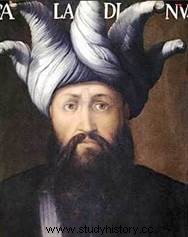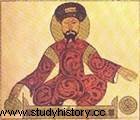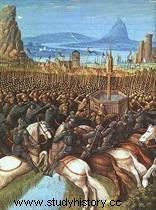 Saladin (1138-1193), of Kurdish origin, was a sultan who founded the Ayyubid dynasty and ruled Egypt and Syria in the 12th century. He entered into legend, both in the West and in the East, for having restored Muslim power in the Middle East and retaking Jerusalem from the Crusaders. His name is also very often associated with exceptional human qualities, which even among his opponents in the West we did not hesitate to describe as "chivalrous". When Saladin died in Damascus in 1193, his immense possessions were divided between his three sons and his brother. Posterity will grant him the status of an Arab hero.
Saladin (1138-1193), of Kurdish origin, was a sultan who founded the Ayyubid dynasty and ruled Egypt and Syria in the 12th century. He entered into legend, both in the West and in the East, for having restored Muslim power in the Middle East and retaking Jerusalem from the Crusaders. His name is also very often associated with exceptional human qualities, which even among his opponents in the West we did not hesitate to describe as "chivalrous". When Saladin died in Damascus in 1193, his immense possessions were divided between his three sons and his brother. Posterity will grant him the status of an Arab hero.
Saladin in the service of the Turks
Born in Takrit, Mesopotamia (now Iraq), Salah al-Din Yusuf al-Ayyubi — called Saladin by Westerners — is of Kurdish descent, from the tribe of Rawadiyah. His family made a fortune in the service (especially military) of Zankî (or Zengi). The zankids come from the Turkish Seldjuk lineage, and Ayyub, father of Saladin, was governor of Tikrit (birthplace of Saladin around 1138, and of…Saddam Hussein) on their behalf, before assisting Nûr al-Dîn during the conquest of Damascus in 1154.
 When Ayyub died, it was his brother Shirkûh who was charged by Nûr al-Dîn (under the authority of the Abbasid caliph of Baghdad) of the Egyptian campaign of 1164, intended to come to the aid of the vizier Shawâr in struggle with the Fatimid caliph Al-Adid. The young Saladin accompanies him, and it is there that he cuts his teeth quickly showing his skill, especially political. Nûr al-Dîn's men, after repelling an attack by the King of Jerusalem Amaury on Egypt, decide to take matters into their own hands:they begin by assassinating Shawâr, the very man they had come to support, and the Saladin's uncle is appointed in his place by the Fatimid Caliph!
When Ayyub died, it was his brother Shirkûh who was charged by Nûr al-Dîn (under the authority of the Abbasid caliph of Baghdad) of the Egyptian campaign of 1164, intended to come to the aid of the vizier Shawâr in struggle with the Fatimid caliph Al-Adid. The young Saladin accompanies him, and it is there that he cuts his teeth quickly showing his skill, especially political. Nûr al-Dîn's men, after repelling an attack by the King of Jerusalem Amaury on Egypt, decide to take matters into their own hands:they begin by assassinating Shawâr, the very man they had come to support, and the Saladin's uncle is appointed in his place by the Fatimid Caliph!
Saladin master of Egypt and sultan
But Shirkûh quickly dies, and Saladin succeeds him; the caliph then makes the mistake of underestimating him. We are in 1169, and the young vizier manages for the next two years to manage an impossible situation:summoned by Nûr al-Dîn, he is therefore a "vassal" of the Sunni Abbasid caliph of Baghdad...but exercises his office under the authority of the Fatimid Shiite Caliph! In 1171, sure of his strength, he eliminated the Fatimid caliph and took Egypt alone.; he then openly becomes a rival of his former master Nûr al-Dîn. However, he died in 1174, and Saladin had no trouble defeating his successors.
In the early 1180s, he established his power over a region ranging from Muslim Syria and northern Iraq to present-day Libya and western Arabian Peninsula, obviously including all of Egypt. However, he already poses as a unifier of Muslims, still under the authority of the Caliph of Baghdad, who confers on him the title of sultan. For this, he decides to choose a common goal for the ummah:jihad for the reconquest of Jerusalem.
Jihad and Jerusalem at the center of its propaganda
As early as the 1170s, he fought against the Crusaders the cornerstone of his policy, organizing real propaganda. He encourages the warlike interpretation of the notion of Jihad, a banner behind which he wants to unite Muslims and establish his legitimacy, in particular vis-à-vis the Zankîdes, "false" fighters of Allah according to him. In this, he perpetuates and amplifies the legacy of Nûr al-Dîn, as shown by the symbolic gesture of returning the minbar of his former master to the mosque of al-Aqsa in Jerusalem. Some historians have insinuated that Jihad was Saladin's pretext for building a personal empire, but there is no denying that he was also a sincere believer. His certain thirst for conquest was not necessarily incompatible with his desire to serve his God.
 It places Jerusalem at the center of its jihadist propaganda, while the city is only the third holiest of Islam. This will be decisive for the campaign of 1187, which will largely create its legend. Indeed, he took advantage of the repeated provocations of his sworn enemy, the very agitated Renaud de Châtillon, to launch a major offensive against the strongholds of the Franks installed in the Latin States in 1186. In the past, he had various fortunes against the Crusaders, including a defeat in 1177 at Montgisard against the young leper king Baudouin IV, but this time he was much better prepared, and above all, he succeeded in unifying all the Muslims of the region behind him. He first triumphed at Hattin in July 1187, where the Crusader army was annihilated and Renaud beheaded by his hand. In the wake of this victory, Saladin seized most of the Christian fortresses, including Jerusalem which, after twelve days of siege, surrendered without bloodshed on October 2, 1187.
It places Jerusalem at the center of its jihadist propaganda, while the city is only the third holiest of Islam. This will be decisive for the campaign of 1187, which will largely create its legend. Indeed, he took advantage of the repeated provocations of his sworn enemy, the very agitated Renaud de Châtillon, to launch a major offensive against the strongholds of the Franks installed in the Latin States in 1186. In the past, he had various fortunes against the Crusaders, including a defeat in 1177 at Montgisard against the young leper king Baudouin IV, but this time he was much better prepared, and above all, he succeeded in unifying all the Muslims of the region behind him. He first triumphed at Hattin in July 1187, where the Crusader army was annihilated and Renaud beheaded by his hand. In the wake of this victory, Saladin seized most of the Christian fortresses, including Jerusalem which, after twelve days of siege, surrendered without bloodshed on October 2, 1187.
The sequel is as well known, especially in the West:the fall of the Holy City and the kingdom of Jerusalem provoked the Third Crusade and the arrival of the King of France Philippe Auguste and especially Richard Coeur de Lion. Arriving in the Holy Land, the Franco-English armies concentrate their efforts on the siege of Saint-Jean d'Acre. Saladin tried in vain to free the city but, finally, it fell into the hands of the Crusaders on July 12, 1191. The Christians, however, failed to take advantage of their victory to retake Jerusalem. On September 2, 1192, Saladin signed a Jaffa peace treaty with Richard the Lionheart:the Muslims kept Syria and Palestine - notably Jerusalem, although they left a right of access to the tomb of Christ, the Holy Sepulcher , to the Christian pilgrims — while the Christians obtain the coast, from Jaffa to Tyre.
On March 4, 1193, Saladin died in Damascus, following a dazzling illness. At his death, his possessions - which extended from Tripolitania (Libya) to Armenia and Yemen - were divided between his three sons and his brother.
Legend and myth of Saladin, from West to East
Saladin's path to posterity was much more complicated and even surprising than one might think.
First of all, it was celebrated first…in West ! From the beginning of the 13th century, songs of gesture celebrate his warlike qualities, but also his great leniency and his courtesy towards women. Those who fought him, like Richard, rave about him, as do those who met him – one source says Eleanor of Aquitaine had a crush on him, which saw his age at the time of Richard's mother's presence in the Holy Land is unlikely, but shows how far the legend can go (especially associated with the nymphomaniac reputation of Louis VII's wife)... - or even those who were his captives, like Sibyl, Queen of Jerusalem, who claims that Saladin treated her remarkably well.
How to explain this positive vision? Mainly probably because it is more rewarding to have fought a valiant adversary, this is particularly the case for a Richard fond of building his own legend, or of having been defeated by an exceptional being. We must not exclude the other legends, darker, about Saladin which, this time, compared him to a demon and a ruthless and bloodthirsty being with as main example Hattin , where he had all the Templars executed. Be that as it may, positive or negative, the legend of Saladin has endured in the West, resumed in the 18th century and until the end of the 19th century, when Emperor William II respectfully visited his tomb in Damascus, participating even at its renovation!
 So what about the Orient? Well, the path is almost the opposite:Saladin is far from being celebrated after his death, even if he enjoys an undeniable prestige thanks to his reconquest of Jerusalem. First, he leaves an empire certainly vast, but very fragile and almost ruined. His difficulties with Richard the Lionheart have also damaged his reputation for invincibility, and his religious tolerance towards dhimmis (Christians and Jews) irritates the most radical ulema (scholars of Islam). Above all, his successors divided and, worse, restored Jerusalem to the Crusaders of Frederick II for a time! They were overthrown by the Mamluks in Egypt in 1250.
So what about the Orient? Well, the path is almost the opposite:Saladin is far from being celebrated after his death, even if he enjoys an undeniable prestige thanks to his reconquest of Jerusalem. First, he leaves an empire certainly vast, but very fragile and almost ruined. His difficulties with Richard the Lionheart have also damaged his reputation for invincibility, and his religious tolerance towards dhimmis (Christians and Jews) irritates the most radical ulema (scholars of Islam). Above all, his successors divided and, worse, restored Jerusalem to the Crusaders of Frederick II for a time! They were overthrown by the Mamluks in Egypt in 1250.
Contemporary posterity
This is the decisive moment that harms the posterity of Saladin, because the new dynasty erects into myth its own hero, Baybars, conqueror of the Mongols and then of the Crusaders. This is the real Muslim hero up to and including the Ottoman Empire… In fact, it was not until the 19th and especially the 20th century that the figure of Saladin reappeared; there are several explanations for this:the context sees an Ottoman Empire weakened against the West and a Turkish caliphate contested by the Arabs at the end of the 19th century, then the emergence of Arab nationalism, especially after the Second World War. In 1948, the creation of the State of Israel is quickly compared with the Latin States.
The reappropriation of Saladin is then almost logical:even Kurdish, he was very Arabized from his childhood and therefore sees himself recovered as a great Arab figure against the Turks as much as against the Hebrews and the Westerners (both assimilated to the Crusaders); winner and conqueror of Jerusalem, he is also the ideal character to express pride but also a call for a “new Saladin”… Throughout the second half of the 20th century, we witness the construction of the Saladin myth in the Middle East:leaders claim it, like Saddam Hussein; statues like that of Damascus are erected to him; and Palestinian groups take the names of some of his victories like Hattin. It is celebrated even in popular culture, by films (like that of Youssef Chahine), but also television series broadcast as far as Indonesia!
Non-exhaustive bibliography
- A.M Eddé, Saladin, Flammarion, 2008.
- J.M. Mouton, Saladin the Knight Sultan, Gallimard, 2001.
